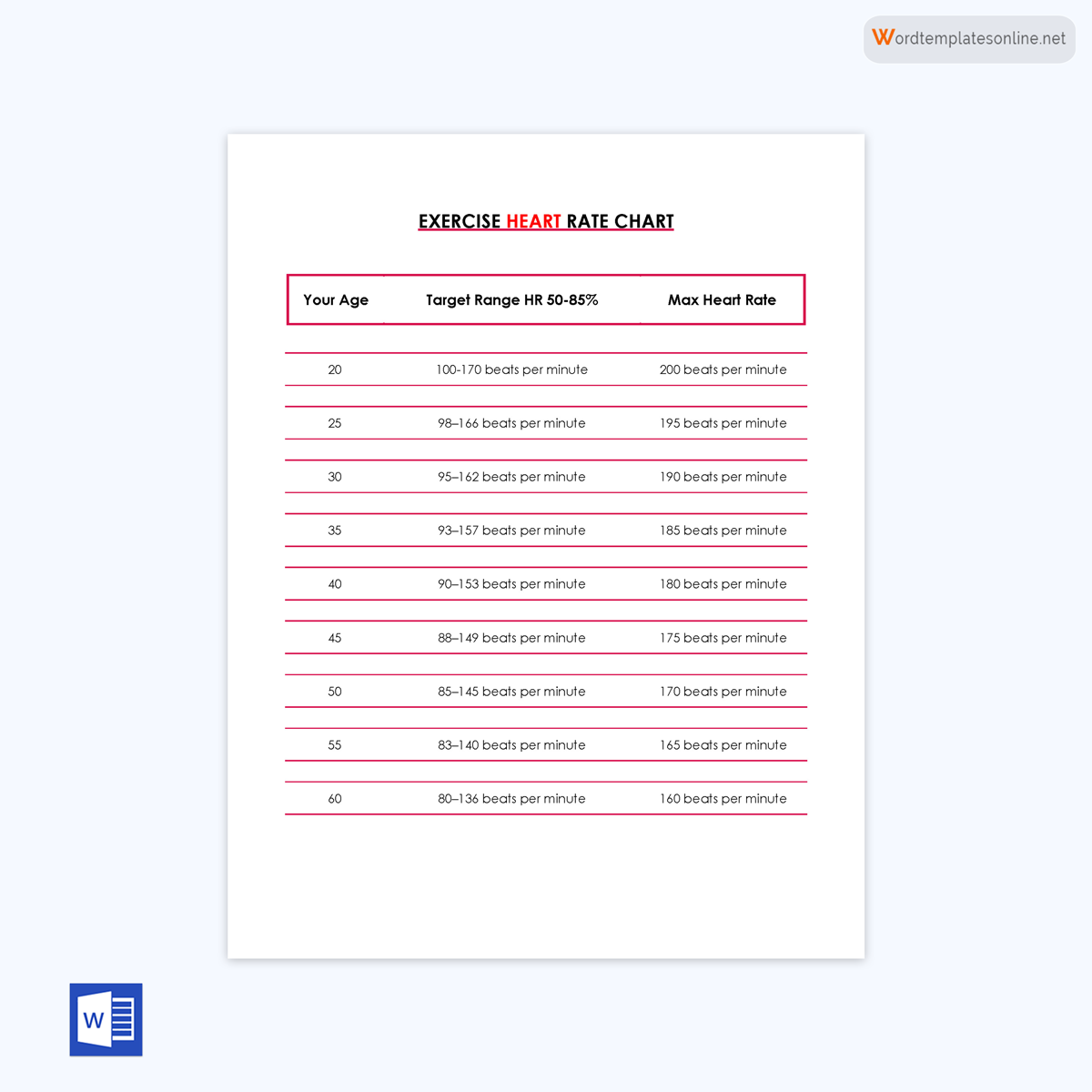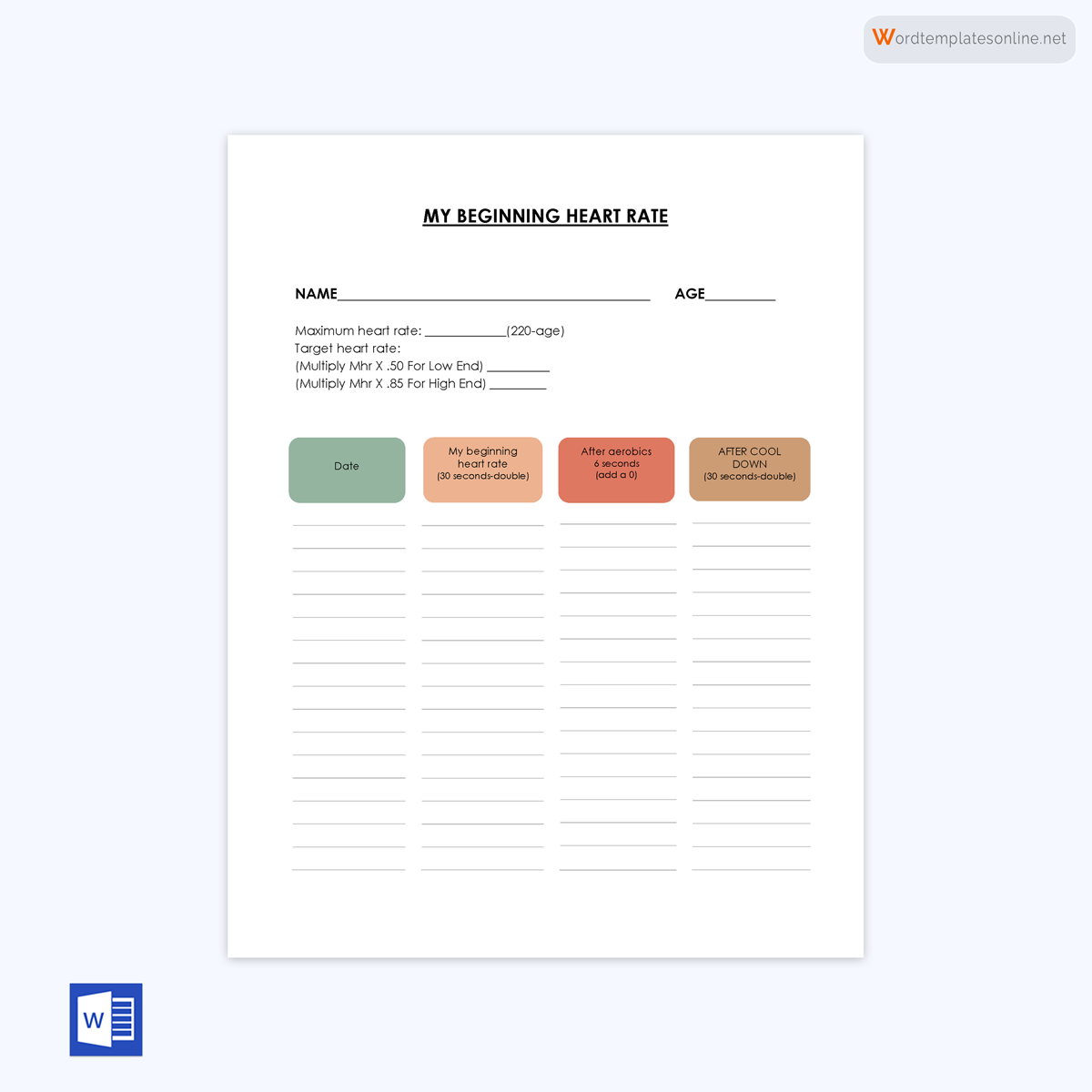Heart rate is the number of times the heart beats in one minute. Pulse, another name for heart rate, differs from person to person and varies with activity.
It is higher when engaging in physical activities, such as exercise, and slower while sleeping. A heart rate chart can help you monitor your heart rate during different types of physical activity at different intensities.
Free Templates
A heart rate chart can evaluate your heart rate based on your workout intensity. Choose your age from any of these four intensity zones to learn the range of beats per minute and the zone you are currently in.


RHR Vs. MHR Vs. Exercise Heart Rate
Heart rates vary based on the number of heartbeats per minute. These categories of heart rates below help you understand at what level your heart rate is operating. It is simple to spot any irregularity in your heartbeat once you are aware of these categories.
The different categories include:
Resting heart rate (RHR)
The resting heart rate is the number of times the heart beats per minute while you are at rest. It is usual for the resting heart rate to vary throughout the day.
RHR should be measured when you are at rest without any influence such as emotion or illness. A normal heart rate for an adult is within the range of 60 to 100 beats per minute (bpm), while that of an athlete could be as low as 40 bpm and is termed as bradycardia in athletes.
A lower heart rate is better and healthier because it indicates a healthy heart and that the heart muscles are functioning well. This means the heart does not have to work hard to maintain a steady heartbeat as opposed to a faster one.
Maximum heart rate (MHR)
Maximum heart rate refers to the highest number of beats your heart makes in a minute.
You are probably at around 60 to 75% of your maximum heart rate when you are in the middle of walking very fast. You may estimate your MHR by subtracting your current age from 220. So, if you’re 28, your MHR is likely 192. This is known as the Astrand Method. However, even though this number may provide a good indication, the result is not very accurate.
Maximum heart rate formula = 206.9 – (0.67 * age)
The formula above calculates your MHR based on an estimated age grade. You can easily get various levels of your target or exercise heart zones using a heart rate chart. However, the formula above is the subject of ongoing research only since it does not provide a decent calculation for people aged over 30.
A more accurate option would be to use a value that is +/- 11 away from the number. So, if you are 33 years old, your maximum heart rate from the calculation above would be 185. Your estimated target heart rate would be between 174 to 196.
Exercise heart rate
Otherwise known as Target Heart Rate describes how fast you want your heart to beat when engaging in a workout or exercise. It serves as an intensity indicator and is dependent on your current fitness level and age. It changes as you age or get fitter. But the information you get about your activity heart rate is as precise as it can be, giving you a general idea of your heart rate when working out.
There are easier ways to find your heart rate, especially using modern smartwatches and fitness trackers. They automatically measure your resting heart rate and use the data to measure and give you a suggested target heart rate. The manufacturers might also upgrade these gadgets to give a more precise figure based on the most recent studies.
How to Find Your Exercise Heart Rate Using Chart?
Monitoring your heart rate is crucial if you want to ensure that you are exercising in the proper heart zone and getting the most benefits from it. However, this heart rate is dependent on certain factors for its efficiency.
They include the following:
Age
The heart is essentially a muscle and could weaken over time. An aging heart relaxes at a lower heart rate compared to a younger heart. As a result, the heart rate during training or a workout decreases with age.
Intensity of exercise
Your heart rate increases as the intensity of exercise increases. The relationship between the intensity of exercise and heart rate can be explained by a person taking a night stroll. Walking will increase the heart rate, but jogging will get your heart pumping really fast.
Gender influence
The heart responds differently to men and women during exercise. Studies show that men typically have a lower resting heart rate and a higher peak rate than women. Also, men’s heart rates tend to increase more during exercise as compared to women’s.
Heart Rate Zone Calculator
Given below is a chart to help you calculate your heart rate when you are resting and exercising. The chart clearly shows how your heart rate varies with different exercise intensities and how you can calculate it.
MHR = Maximum Heart Rate
RHR = Resting Heart Rate
THR = Target Heart Rate
Bpm = Beats per minute
MHR = 220 – age
THR = MHR x %intensity
| Target Zone | %Intensity | THR in bpm |
| Maximum Zone | 90 – 100 | 160 – 178 |
| Hard Aerobic Zone | 80 – 90 | 142 – 160 |
| Moderate Aerobic Zone | 70 – 80 | 125 – 142 |
| Fat Burn Zone | 60 – 70 | 107 – 125 |
| Warm Up Zone | 50 – 60% | 89 – 107 |
Target heart rate
Below is a chart that shows heart rates for different exercise levels and ages. A typical workout session can be grouped into four categories: low intensity, moderate intensity, aerobic zone, and maximum intensity.
Their target heart rates are as follows:
| Age | Low Intensity (57% – 63%) | Moderate Intensity (64% – 76%) | Aerobic Zone(70% – 80%) | Vigorous Intensity(77% – (95%) | Maximum Intensity(96% – 100%) |
| 25 | 95 – 114 | 114 – 134 | 133 – 152 | 143 – 162 | 190 |
| 35 | 92 – 110 | 110 – 128 | 128 – 147 | 138 – 156 | 183 |
| 45 | 88 – 106 | 106 – 124 | 124 – 141 | 133 – 150 | 177 |
| 55 | 95 – 102 | 102 – 119 | 119 – 136 | 128 – 145 | 170 |
| 65 | 82 – 98 | 98 – 114 | 114 – 131 | 123 – 139 | 163 |
| 75 | 78 – 94 | 94 – 110 | 110 – 125 | 117 – 133 | 157 |
Normal heart rates by age range
The table below shows the relationship between the ages of children and their corresponding heart rates. It has been demonstrated that older hearts produce fewer beats per minute than younger hearts.
| Age Range | Heart Rates (beats per minute) |
| Newborn | 100 – 160 |
| 0 – 5 months | 90 – 150 |
| 6 – 12 months | 80 – 140 |
| 1 – 3 years | 80 – 150 |
| 3 – 5 years | 50 – 120 |
| 6 – 10 years | 70 – 100 |
| 11 – 14 years | 60 – 105 |
| 15 years + | 60 – 100 |
Resting heart rate values for men
The table below shows the men’s resting heart rates according to age and exercise levels:
| Age | 18 – 25 | 26 – 35 | 36 – 45 | 46 – 55 | 56 – 65 | 65+ |
| Athlete | 40 – 52 | 44- 50 | 47 – 53 | 49 – 54 | 51 – 56 | 52 – 55 |
| Excellent | 56 – 61 | 55 – 61 | 57 – 62 | 58 -63 | 57 – 61 | 56 – 61 |
| Good | 62 – 65 | 62 – 65 | 63 – 66 | 64 – 67 | 62 – 67 | 62 – 65 |
| Above Average | 66 – 69 | 66 – 70 | 67 – 70 | 68 – 71 | 68 – 71 | 66 – 69 |
| Average | 70 – 73 | 71 – 74 | 71 – 75 | 72 – 75 | 72 – 75 | 70 – 73 |
| Below Average | 74 -81 | 75 – 81 | 76 – 82 | 76 – 81 | 76 – 81 | 74 – 79 |
| Poor | 82+ | 82+ | 83+ | 82+ | 82+ | 80+ |
note
Women’s heart rates are faster than those given above for men by an average of 2–7 beats per minute.
Different Ways to Monitor Your Heart Rate
Monitoring the heart rate today is easier than it used to be in the past, thanks to the modern fitness devices available. Nevertheless, the traditional method of monitoring the heart rate is still valid.
Three different ways of monitoring the heart include the following:
Take pulse
The carotid and radial arteries in your neck and wrist, respectively, can be used to determine your pulse. You will need a timing device that counts in seconds, e.g., a smartphone’s stopwatch or timer.
The carotid arteries can be felt by gently placing two fingers on the neck on each side of the windpipe.
Take note not to use your thumb, as the arteries in the thumb could make it difficult to count accurately.
Once you locate your pulse, press lightly on it, count how many beats you can feel in 15 seconds, and multiply by 4. So, 18 beats per minute for 15 seconds equals 72 beats per minute.
You may need to pause to locate your pulse if you are walking. Once you have it, continue walking while taking the pulse at a slower pace.
Use a heart rate monitor
Heart rate monitors are a more accurate alternative to taking your pulse. They transmit your pulse via a mobile app or wrist device, so you can keep track of your heart rate throughout your workout.
The features of the heart rate monitors depend on how much they cost; the more expensive ones also have features like tracking heart rate zones and counting calories burned. Some can even estimate how long it will take you to get back to your RHR.
Use a fitness tracker or smartwatch
Smartwatches have pulse sensors close to the skin that help get an accurate reading of one’s pulse. Smartwatches do not read pulses continuously to preserve battery life. However, you can read your device’s instructions to enable it for continuous pulse reading.
Frequently Asked Questions
It depends on how intense your workout is. By reaching your target heart rate, you can maximize the benefits of any gym workout program. If you work out at home, it can help monitor your health and fitness progress.
While it is not so common, some people have a resting heart rate below 60 bpm. This is common among professional athletes and people who are reasonably fit. It would be a concern if you are not physically active and are not taking any medications, but your heart rate still falls below 60 beats per minute. See a doctor in such a case.
When it comes to higher or lower heart rates, lower is typically preferable. The normal heart rate is within the range of 60 to 100 bpm. You may want to talk to your doctor if you continue to experience heart rates above 100 bpm so he can conduct some tests to rule out any serious issues.
Your overall health is indicated by your resting heart rate, so keeping track of it is crucial. One sign that your heart is not functioning as well as it should, for instance, is a heart that has a consistently high RHR.
The typical resting heart rate for a child varies with the child’s age. Babies 3 months and younger: 100 to 150 bpm; kids from 1 to 3 years: 70 to 110 bpm; kids from 4 to 6 years: 80 to 115 bpm; kids from 7 to 9 years: 70 to 110 bpm.
Avoiding a sedentary lifestyle, staying hydrated, getting enough rest, avoiding caffeine, and maintaining a healthy weight are a few helpful suggestions to reduce your resting heart rate.



![Graph Paper Guide and Templates [2021]](https://www.wordtemplatesonline.net/wp-content/uploads/2021/03/Graph-Paper-Guide-and-Templates-2021.jpg)




